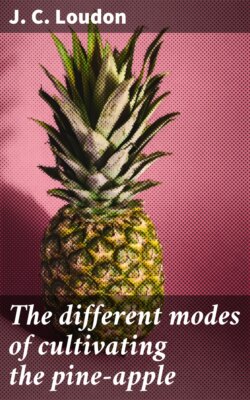Читать книгу The different modes of cultivating the pine-apple - J. C. Loudon - Страница 5
На сайте Литреса книга снята с продажи.
CHAP. II.
OF THE VARIETIES OF THE PINE APPLE.
ОглавлениеTable of Contents
Of the Pine Apple, as of most other fruits that have been long in cultivation, there are many varieties. The principal part of those cultivated in this country have been obtained from the West India islands; but some also have been raised in this country from seed.
Speechly states, that, in the year 1768, he raised seventy plants from seeds that were sent to the Duke of Portland from the West Indies, most of which varied distinctly either in the leaves or fruit, but the quality of the latter was very inferior.
The most esteemed varieties in present cultivation are:
1. The Old Queen. Fruit oval-shaped, and of a gold colour. Esteemed the hardiest kind, and fruited in fifteen or eighteen months. The fruit grows to a large size, often weighing from three to four pounds. It is much more certain of shewing fruit at a proper age and season than most of the other sorts, and has a just preference in most hot-houses.
2. Ripley’s New Queen. A sub-variety of the Old Queen, with a large elegant fruit; fruited also in an equally short period.
3. Welbeck Seedling; fruit small, generally broader at the head than at the base; of a pale yellow, or sulphur colour, with very flat pips; flesh white and tender, rich in flavour, with less acidity than is found in most other pines. Hort. Trans. iv. 213.
4. Pyramidal, or Brown Sugar-loaf. Cone-shaped, and dark coloured till it ripens; the leaves brownish, the flesh yellow.
5. Prickly Striped Sugar-loaf. Cone-shaped, the fruit of a golden colour, the leaves striped with black or purple lines.
6. Smooth Striped Sugar-loaf; similar to the above, but the leaves not prickly.
7. Havannah. Tankard-shaped; dark coloured till it ripens.
8. Montserrat. The leaves of a dark brown, inclining to purple in the inside; fruit middle-sized and tun-shaped, and the pips or protuberances of the fruit larger and flatter than in the other kinds.
9. King Pine, or Shining Green. The leaves of a grass-green, with few prickles, the pulp hard and rather stringy, but of good flavor when ripe.
10. Green, or St. Vincent’s Pine. A rare variety; when ripe the fruit is of an olive hue, middle-sized, and pyramidical.
11. Black Antigua. The fruit is shaped like the frustum of a pyramid: leaves of a brownish tinge, and drooping at the extremities, with strong prickles, thinly scattered. The pips of the fruit are large, often an inch over; and it attains a large size, weighing from three to four pounds. It is of a dark colour till it ripens; very juicy, and high flavoured.
12. Black Jamaica. The fruit is large, and the plant similar in character and habits to the above.
13. Providence Pine. There are two varieties, the white and green; the fruit is larger than that of any of the kinds cultivated in this country; the form inclining to pyramidical; the colour, at first, brownish grey, but, when mature, of a pale yellow. The flesh yellow and melting, abounding with quick lively juice. Speechly produced in the gardens at Welbeck, in 1794, a fruit that weighed five pounds and a quarter, or eighty-four ounces, and from a plant that was not a large one. Griffin had, in 1803, two plants placed under his care, which fruited in July 1804; the fruit of one plant weighing seven pounds two ounces, and the other nine pounds three ounces, avoirdupois. This sort, and the two preceding, require generally three years, and sometimes four or five, to produce their fruit.
14. Blood-red; fruit equal in bulk at both ends. Pips of moderate size; colour brick-red; flesh white and opaque; leaves of a changeable hue; the flavor of the fruit being inferior to that of most others; this is to be considered merely as a curious variety. Hort. Trans. iv. 214.
15. Silver-striped Queen. Leaves beautifully striped with white, yellow, and red; but the plant, though elegant, is a reluctant fruiter.
16. Variegated-leaved Pines. Besides the Striped-leaved Queen, there are several sorts with beautifully varied leaves and fruits; but in general they are tardy in fruiting, and more to be considered as ornamental than as useful varieties.
To these may be added, as sorts not generally known, or of inferior value:
The Smooth Pine. Miller. The Smooth Long Narrow-leaved Pine. Ibid. The Grunda Pine. Ibid. The Bogwarp Pine. Ibid. The Surinam Pine. Ibid. The Antigua Queen. Speechly. The Green Providence, or Old Providence, from one of the Bermuda islands of that name.
New Sorts. Pine plants are frequently imported from the West India islands, and in this case generally bear their names. In general, however, these plants are far inferior, both as to kinds and condition, to those grown, and to be procured from nurserymen in this country. They are generally infested with the bug, and very uncertain in their time of fruiting, as well as to its flavor. If these were to be enumerated, the list of pines known in this country would amount to upwards of forty sorts. Specimens of above thirty sorts are grown in the gardens of Mr. Gunter, at Earl’scourt.
The Pine Apple, as every gardener knows, is propagated in the same manner by all those who grow it; that is, by that singular production in which the fruit terminates, called a crown, and by suckers; these are planted in small pots, or in beds of rotten tan, earth, or dung, at first, and shifted in regular gradation into pots of different sizes, at the discretion of the cultivator.
